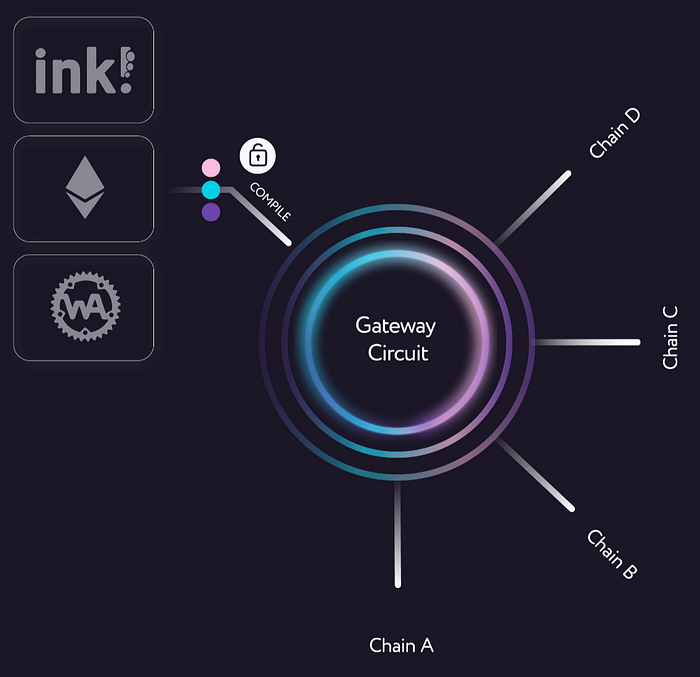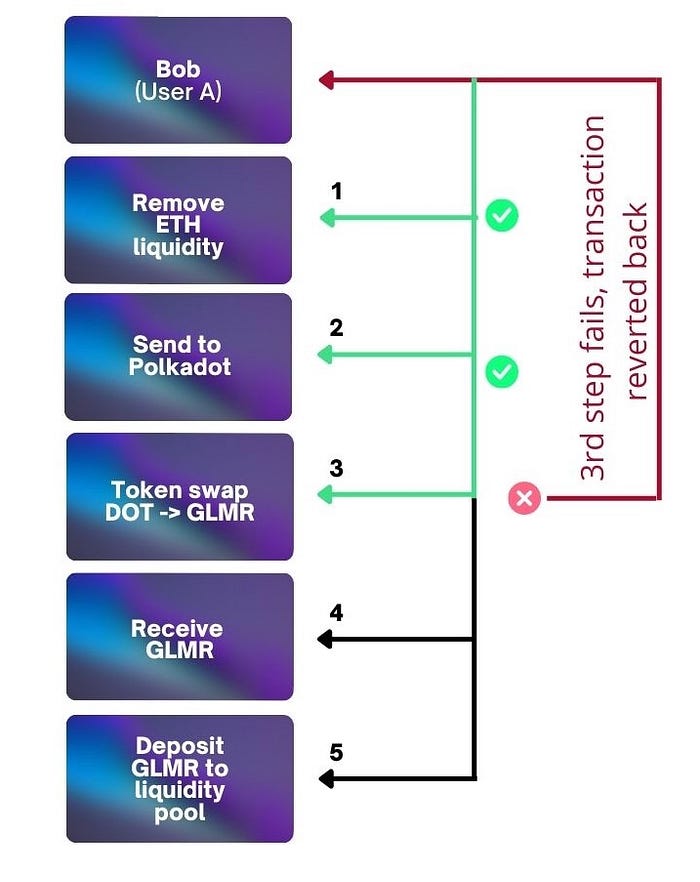What is t3rn?
t3rn is a smart contract hosting platform, allowing trustless cross-chain smart contract execution that guarantees success or full reversion of all execution effects in a multichain transaction; this means funds are never at risk, should anything fail in the transaction, or vulnerable to being hacked. The development of t3rn has been made possible through the Web3 Foundation Grants Program and t3rn will be operating as a Polkadot Parachain as a means of guaranteeing stability and security.
The ultimate objective of t3rn is to allow trust-free collaboration between blockchains and create an ecosystem in which anyone can utilize and deploy an interoperable smart contract, where developers are fairly remunerated for their contributions.

What are the challenges with bridging security?
The current popular bridging solutions are based on multiple parties co-signing transactions. Participating in these systems is either open or closed.
- Open: PoS based (Proof-of-stake, significant stake holding model).
PoS consensus requires blockchain participants to stake an important quantity of tokens in a network, incentivizing them to act in its interests in order to validate blocks. - Closed: PoA based (Proof-of-authority, federated systems).
By leveraging identities, PoA consensus algorithm makes block validators not staking coins but their own reputation by carefully choosing them and having their identity made public.
They both have their weaknesses and strengths, but generally, the problems center around:
- Poor security design of bridge consensus
- High risk of collusion
- Buggy implementation prone to exploits
t3rn facilitates simple bridging implementation; bridges commonly allow communication between two chains, and projects need to set it up independently. Through t3rn’s unique Gateway solution and flexible architecture, t3rn can easily integrate with any blockchain, regardless of whether it is programmable or not, allowing any project to seamlessly step into the cross-chain future.
Usually, bridges have to hold a large amount of tokens on the native and target chain to perform bridging operations, attracting malicious actors that are trying to exploit the contracts holding those funds.
If they are able to exploit any bugs in a smart contract, it can give them access to all of the locked funds. These hacks have happened several times, the Ronin Bridge exploit being one notorious example. Hackers were able to get access to multiple validators’ accounts and approve malicious transactions that let the hacker drain over $600M of locked assets from the bridge contract. The conclusion to be made is that these contracts act as a potentially vulnerable source of assets and can be regarded as potential attack vectors.
Another type of risk concerns wrapped tokens. These are a copy of the value of a native token (supposed to hold a one-to-one peg) allowing it to be transferred from one blockchain to another. An underlying asset (native asset) is sent to a custodian (an entity holding the same value of the native asset and newly-minted asset) who keeps it in a digital vault using a smart contract. Once the asset is locked, custodians mint the new wrapped asset to be used on another blockchain.
The risk lies in the smart contracts, representing those wrapped assets. If those smart contracts are not audited or not well designed, there is a risk that malicious actors can exploit the contract to mint wrapped assets at will and then exchange them for the native assets.
t3rn guarantees security through its protocol design. If a user submits a transaction to t3rn protocol, an Executor who accepts the requested transaction has to lock the requested amount in an escrow contract first and then provide the inclusion proof. Once the Circuit checks the inclusion proof and verifies that the output matches ordered input, the funds are transferred from the escrow account to the accounts on the destination chains. An important feature to highlight is that the protocol does not necessarily need to wrap assets to bridge them over to the destination chain, as it only requests the amount on the target chain. That means we do not have permanent liquidity sitting in a single contract that is an appealing target to malicious actors. This is just a high level view of the t3rn protocol, there will be a more detailed description of the protocol soon
What is the t3rn smart contract hub?
The t3rn smart contract hub is a hosting platform for smart contracts written in the most widely adopted programming languages including Solidity, ink!, WebAssembly or anything that compiles to WASM.
Smart contracts stored on the t3rn platform can be used by anyone, while the developers that contribute smart contracts to the open-source repository may choose to get remunerated anytime their code is executed. Additionally, the t3rn protocol distributes a significant part of the gas fees the smart contract generates back to the original contract author.
The objective is to be a decentralized repository of composable smart contracts, where businesses and developers share solutions.
t3rn truly aims to create an ecosystem for developers contributing to the t3rn open-source repository, creating a self-sustaining, smart contract ecosystem, serving the blockchain community and helping businesses and other blockchain projects utilize smart contracts for better use cases.
How do we achieve trustless cross-chain execution?
As of today, smart contracts are generally limited to the blockchain on which they are deployed, meaning if a smart contract is deployed on Ethereum, it cannot access data on Polkadot, as an example. This limits their usability and applicability, as well as vertically precluding connectivity between different blockchains.
t3rn aims to solve this issue by creating trustless cross-chain execution with fail-safe mechanisms built into the protocol. In other words, t3rn not only solves smart contract interoperability, but if a transaction fails at any point during a cross-chain execution between blockchains, we can revert to the effect that has occurred to that given point.
One way to conceptualize this is to consider a multi-step transaction on a single ledger system, such as Ethereum, in which the user runs out of gas; the transaction will revert back. t3rn maps this principle to the cross-chain realm.
Below is an example of the t3rn protocol in action: a user wishes to remove liquidity on Ethereum, send it to Polkadot, do a token swap on Polkadot, receiving GLMR and deposit that into a liquidity pool on Moonbeam; this can be done using a single cross-chain execution with t3rn, with the confidence that if anything fails in this five-step transactions all effects up until that point will revert back.

A first look at t3rn interface
The t3rn user interface showcases how cross-chain execution with t3rn enables users to compose fail-safe transactions on all integrated blockchains by selecting different functionalities and arranging them in chronological steps. The t3rn UI will support multiple wallets such as MetaMask and polkadot.js.

t3rn interface
What is XBI?
t3rn has also received a second grant from the Web3 Foundation grant to create XBI, a standardized format for XCM.
XCM is the native cross-consensus messaging format of Polkadot, that allows parachains to communicate, enabling cross-blockchain transfers of assets and data. XBI is a new standard for fail-safe and trustless cross-chain execution. It will allow parachains to communicate seamlessly, granting them to call any functions and facilitate cross-chain messaging with other integrated XBI parachains. The standard will become more “plug-and-play” to considerably reduce the development time for cross-chain interactions.
The XBI standard will be proposed as a PSP (Polkadot Standard Proposal). PSPs are standards that fit the Polkadot ecosystem needs. The engagement of the entire community is needed in order for it to be valuable and everlasting.
To be remembered
- t3rn is a smart contract hosting platform that allows for interoperable smart contract execution between different blockchains.
- t3rn can easily integrate with any blockchain, allowing any project to seamlessly step into the cross-chain future.
- t3rn is a hosting platform for smart contracts that welcomes both Solidity and Ink! developers.
- Developers that contribute smart contracts to the open-source t3rn repository can choose to get remunerated anytime their code is executed.
- t3rn is a safer and more secure way to execute smart contracts.
- t3rn is more reliable than other bridges, as it has a fail-safe feature.
- The XBI Standard is a high-level interface that will make it easier to have interactions between different types of consensus systems.
- t3rn allows for composable smart contract executions across different blockchains and consensus systems.
- t3rn offers a sleek user interface that allows users to compose, submit and watch multi-chain transactions execute.
- t3rn will launch as a Parachain.
If you are interested in learning more about t3rn or joining our community, please visit our website or follow us on social media. We will continue to update our followers with the latest news and developments from the t3rn team.
